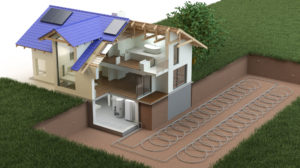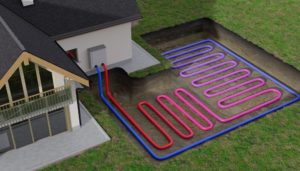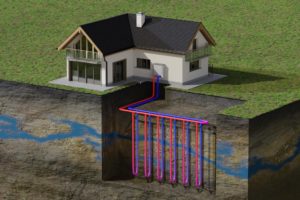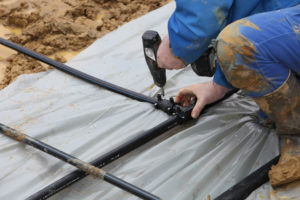Most of the homes in the UK are transitioning to become energy-efficient. Therefore, maybe it is time for you to reconsider your energy devices. One of the essential requirements of any household is heating. A ground source heat pump (GSHP) is one of the most efficient devices.
Also known as geothermal heat pumps, these devices take energy from the ground. By installing this system, you can reduce your reliance on fossil fuels. Furthermore, geothermal energy has both cooling as well as heating applications!
The sudden surge of heat pumps has encouraged most people in the UK to be a part of this change. Therefore, even though ground source heat pumps cost quite a bit, people are still trying to install them. The reason is twofold: it considerably reduces energy bill costs. And the second one is that it lowers your carbon footprint.
But before you choose the right GSHP for your house, there are many things to consider. One of the biggest questions is: How much will this system cost you? To find out the various angles to this question, read this article!
Contents
Key Takeaways
- Ground source heat pumps (GSHPs), or geothermal heat pumps, are an efficient way to heat and cool homes in the UK while reducing energy bills and carbon footprints.
- The cost of a GSHP system varies based on factors like the type of heat pump, the size of the house, and the ground loop type (horizontal, vertical, or lake/pond). Costs can range from £8,500 for small residential installations to £25,000 for commercial projects.
- Additional factors influencing the cost include complexities in installation, geographic location, and conditions. Homeowners can reduce expenses by getting free quotes, insulating their homes, draught-proofing, and taking advantage of the UK government’s Boiler Upgrade Scheme. Alternatives to GSHPs include air source heat pumps and gas boilers, each with cost and environmental considerations.
What Is a Ground Source Heat Pump?
Ground source heat pumps are one of the most fabulous creations of energy-efficient technologies. There are various uses of a GSHP. It can cool or heat your home space. Some can heat your water for multiple uses, such as bathing, washing, or cooking.
They are highly efficient in reducing your energy expenses. The reason behind this is that they extract heat from the air, which is a natural resource. Consequently, they help in keeping global warming in check.
The eradication of fossil fuels for energy generation has made GSHP a top-notch choice for the people of the UK. There is a huge demand in typical households and industrial settings.

How Much Does a Ground Source Heat Pump Cost
The expense of owning a ground source heat pump consists of two segments. This includes the price of the ground source heat pump and the cost of possessing the pump. The price of the heat pump depends on the type and size you choose.
So if you have a small house, the maximum expense can range to £8500. This will include the installation plus the price of the pump. However, for commercial heating projects, the maximum amount can go to £25,000.
Apart from the size of your house, the cost of a ground source depends on its type: horizontal or vertical.
Ground source heat pump installation also depends on where you live. This is because the quality of ground and the space around your house is a substantial cost-deciding factor.
The overall initial cost can seem pretty high. Although, in the long term, it pays off well as an investment. It is suitable for the environment as a GSHP uses renewable energy and is also cheaper to maintain. The following factors determine the overall cost of your GSHP system.
Buying a Ground Source Heat Pump
As discussed above, the basic cost of a GSHP is the amount spent on purchasing the heat pump and its complementary components like piping, coolant, etc. Apart from equipment, you’ll also need to buy other compatible parts necessary to connect the GSHP with your house’s heating and hot water system.
All components required for installing a ground source heat pump will cost you between £2800 and £7500. This cost will vary primarily depending on the size of the system you buy, determined by your home’s size.
Ground Loop Type
Vertical, horizontal, and lake/pond are the three major kinds of ground loops used with ground source heat pump systems.
Lake/Pond
Lake/pond ground loops are the least common as they require living close to a deep and big enough water body. Where the water body is of appropriate size, a series of plastic pipes are immersed in the water body filled with heat-transfer appropriate fluids.
These systems take benefit of the high specific heat of water instead of having to be buried underground. Your GSHP connects to these immersed pipes, which transfer the heat to your home.
As this system does not require any digging, these systems are mostly the cheapest to install and maintain.
Horizontal
Horizontal ground loops are most common because of their cost-effectiveness. The series of heat transfer pipes are laid in a horizontal mesh buried underground. The system extracts the heat of the earth’s crust and transfers it to your home for heating.
The mesh must be laid at 1.2 metres below the surface or deeper. This avoids any environmental or man-made changes at the surface like rain, drought, etc., from affecting the system. The deeper the installation, the more effective the system will be.
However, this kind of mesh system requires digging trenches. The manpower and machines used will increase the installation cost of your GSHP.
The installation cost of a GSHP system with a horizontal ground loop ranges between £6000 and £12000, depending on the house’s size.

Vertical
Vertical ground loops are less common because of the complexity and cost of installation. The heat transfer pipes, in this case, are laid vertically into the earth’s surface-reaching depths of up to 120 metres. Similar to horizontal systems, the depth of the vertical boreholes determines the system’s effectiveness.
As this requires digging deep boreholes, which on average are around 70 metres deep, they are costly to install. Installing a ground source heat pump with a vertical ground loop costs between £8500 and £18000.
Complexities in Installation
Retrofitting a new ground source heat pump with your house’s pre-existing duct system might come with its own set of complications. The installer will have to find additional parts to make them work together. Or, if the old duct system is outdated, you might also need to reinstall it.
These complexities or requirements of extra upgrades will add to the cost of your GSHP. Although, updating your home’s old duct system might be a good idea if you change your heating system.
Geographic Location and Conditions
The ground type and accessibility of your house also influence the cost of a GSHP installation. Horizontal trenches or vertical boreholes must be dug in most cases, requiring heavy machinery and manpower.
Remote houses or houses in inaccessible terrain will increase installation costs as the cost of transporting the machinery will increase.
The presence of hard or rocky ground will increase drilling effort and time, increasing the cost of labour and installation costs.

Things You Can Do to Reduce the Expense
Get Free Quotes
Choosing the right GSHP for your house can be a daunting task. There are many factors and brands to take into account. However, you can make your task much easier in the very beginning. Most of the local heat pump installers can give you a free quote.
Confused about what this means? Well, it’s a free cost analysis that your local installer can do for you. Usually, an engineer comes to visit your house. They can lay down all the possible options that suit your budget and house and house requirements.
Not only this, but they can also provide you with multiple suggestions to make your more energy efficient. However, there is no requirement to stick to the same installer. You can proceed only if the analysis is compatible with your needs.
Nothing is worse than spending a significant sum on a heating system that is not the best for you. Therefore, it’s wise to do research well if you are switching to a renewable energy heat generator. And who is better than a technician who has expertise in this area?
Do the Intelligent Thing and Insulate!
As mentioned earlier, the expenses of your GSHP include the running costs as a factor. Consequently, it depends on how much heating your house will require. Now, this is where you can try a few hacks to considerably reduce your monthly expenses.
All you have to do is look for ways to maximise your home’s heat retention. The best way to stop warmth from escaping from your home is to insulate it. You can carpet your floors to keep it warmer. This acts as a material that traps heat in it.
Similarly, you can also insulate walls, ceilings, or lofts for maximum retention. The average cost of home insulation varies between £2500- £8500.
After Installation Comes Draught Proofing!
After insulating your home, the next important job is to draught-proof it. According to energy saving trust, draught-proofing your house costs around £225. So if you think about it, it’s cheap and saves you tons!
To drought-proof your apartment or home, you must look for cracks, creaks, or small holes that might be an outlet for hot air. To begin with, seal the chimney hole and block the fireplace when not in use.
Then look for window panes, the space between doors, etc. Seal everything using foams or rubber material. If you want, you can even double glaze your windows.
These small things will retain lots of heat. Eventually, your monthly bill will be less. Moreover, through insulation and draught proofing, you can settle for a smaller motor which will cost less!
Government Schemes
To support UK households in adopting eco-friendly heating solutions and reducing their carbon footprint, the government has introduced the Boiler Upgrade Scheme (BUS). This scheme offers substantial grants to homeowners in England and Wales who install biomass boilers or other renewable heating systems, such as air or ground source heat pumps.
The Boiler Upgrade Scheme provides a direct grant to help cover the initial installation costs, making green heating technologies more accessible and affordable. For example, homeowners can receive grants of up to £7,500 for installing air source heat pumps and £6,000 for ground source heat pumps. This initiative is part of the UK’s broader strategy to encourage energy efficiency, support the transition to renewable energy sources, and move towards achieving net-zero carbon emissions by 2050.

Other Alternatives to Ground Source Heat Pumps
As stated earlier, a ground source heat pump can be much costlier than a gas or an air source heat pump. But their long-term advantages justify the cost. However, sometimes other heat sources might be more suitable for your needs. Therefore, before you decide to go for a GSHP, it’s wise to compare costs. Here are two alternatives for your heating needs:
Air source heat pump
This system is another energy-efficient heating device you can use for your home. Just like geothermal heating pumps, this system derives energy from a renewable energy source. The only difference is that while GSHP uses earth’s energy for your house needs, the air source heat pump relies on air’s heat. Roughly, this system comes at half the price of a ground source heat pump.
Gas Boilers
Even after the UK’s major efforts to reduce carbon emissions by 2050, most houses use gas boilers. This system uses fossil fuels to generate heat or hot water. Although much cheaper than GSHP, gas boilers emit harmful gases into the environment. Moreover, their incurring cost is high because it depends on the non-renewable source of energy. If you compare, these are 1/4th times cheaper than GSHP. But what long-term price are we paying for it?
Heat Pump Source: Reliable Heating and Cooling Solutions
At Heat Pump Source, we take pride in our unwavering commitment to serving the UK with top-tier HVAC solutions. From the efficiency of heat pumps and the cool relief of air conditioning to the warmth of boilers, radiators, and underfloor heating, our dedicated team is always at the forefront of innovation. We understand the unique needs of every household and business, and we strive to provide dependable health and cooling products and services that are tailored just for you. Ensuring your comfort and satisfaction is our utmost priority. Whether you have questions, need guidance, or require support, we’re always here to assist. Please don’t hesitate to contact us; we’re eager to be of service.
Bottom Line
To conclude, the cost of having a ground source heat pump doesn’t have a straightforward answer. Therefore, you will have to consider all the factors that give you your final answer. The best way to start this journey would be to get a free quotation. Then you can go about analysing your needs and budget. Finally, whatever ticks all criteria can be your perfect choice of a GSHP.
Even if not for immediate monetary issues, you can consider installing a GSHP for the future. The long-term expense and maintenance of a ground source heat pump are inexpensive. Moreover, as a citizen of the UK, it will allow you to achieve the dream of an energy-efficient future. This green initiative can be your small step toward securing a better tomorrow.
About the Author
At Heat Pump Source, our articles are the product of a collaborative effort among a team of highly skilled HVAC experts. Our dedicated professionals, hailing from diverse backgrounds in heating, ventilation, air conditioning, and refrigeration, contribute their extensive knowledge and experience to every piece of content. This multidisciplinary approach ensures comprehensive coverage. Our commitment is to deliver authoritative, reliable, and tailored advice to meet the unique needs of every household and business across the UK.

